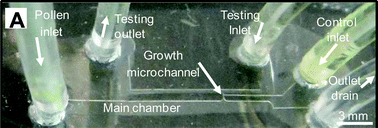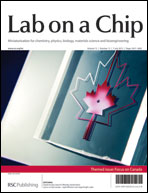Quantification of the Young's modulus of the primary plant cell wall using Bending-Lab-On-Chip (BLOC)
Abstract
Biomechanical and mathematical modeling of plant developmental processes requires quantitative information about the structural and mechanical properties of living cells, tissues and cellular components. A crucial mechanical property of plant cells is the mechanical stiffness or Young's modulus of its cell wall. Measuring this property in situ at single cell wall level is technically challenging. Here, a bending test is implemented in a chip, called Bending-Lab-On-a-Chip (BLOC), to quantify this biomechanical property for a widely investigated cellular model system, the pollen tube. Pollen along with culture medium is introduced into a microfluidic chip and the growing pollen tube is exposed to a bending force created through fluid loading. The flexural rigidity of the pollen tube and the Young's modulus of the cell wall are estimated through finite element modeling of the observed fluid-structure interaction. An average value of 350 MPa was experimentally estimated for the Young's modulus in longitudinal direction of the cell wall of Camellia pollen tubes. This value is in agreement with the result of an independent method based on cellular shrinkage after plasmolysis and with the mechanical properties of in vitro reconstituted cellulose-callose material.

- This article is part of the themed collection: Focus on Canada

 Please wait while we load your content...
Please wait while we load your content...